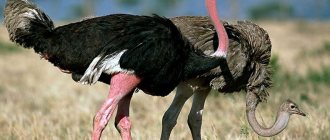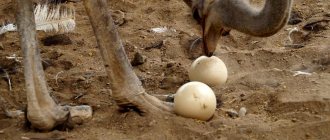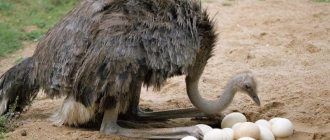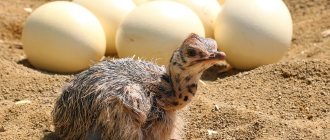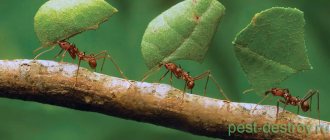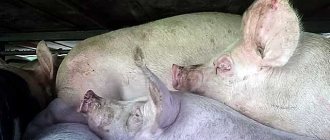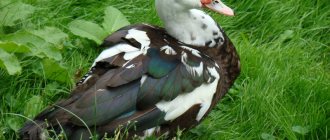An ostrich's eyes are bigger than its brain.
The eyes of the largest bird on planet Earth are larger than its brain .
This amazing fact is fully confirmed by objective data. Thus, scientists have found that the average weight of the ostrich brain is 42.1 g, and the eyes are 47.6 g. And given that there are two eyes, their total average weight is 95.2 g, which is more than twice as much. than the weight of his brain. The ostrich received such an amazing and incredible combination during evolution. The fact is that an ostrich needs excellent vision to survive - after all, it must see both potential food and enemies that can sneak up while it is busy hunting. Therefore, for many centuries, those ostriches whose eyes had the greatest vigilance and field of vision survived and left offspring. As a result, modern birds were formed, which have huge eyes that allow them to see far and wide around them. But the ostrich’s brain does not have a cortex, as a result of which the bird has only instincts. To ensure the functioning of instincts and maintain the normal functioning of vital organs, a very small volume of the brain is sufficient, which is what the ostrich has.
That is, in the process of evolution, the ostrich received huge eyes, necessary for its survival, and a small brain, which is sufficient to ensure the functioning of vital organs and, accordingly, maintain life, breed offspring and implement other instincts.
The site provides reference information for informational purposes only. Diagnosis and treatment of diseases must be carried out under the supervision of a specialist. All drugs have contraindications. Consultation with a specialist is required!
Source
Features of the bird
It is a widely known fact that ostriches do not fly. They cannot fly due to their skeletal structure, plumage and large body mass. But they move faster than a horse. Even small ostrich chicks, about a month old, are already capable of running at a speed of 50 km/h. This is not their only feature.
Ostriches differ from other representatives of the class in the structure of their fingers. They only have two toes. One of them is keratinized. This helps well when walking and long runs. The long claw on the thumb resembles the hooves of camels. The literal translation of the name of ratites into Russian sounds like “camel sparrow”.
Another feature is the egg. The African ostrich has the largest egg. One of these can easily fit 24 chickens. If we compare it with the size of the bird, then this ratio will be slightly less than that of a chicken.
It was mentioned above that among all ladies there is a dominant one. She is the one who hatches the chicks. The male is preparing the nest. Everyone else lays eggs in it. The main female places her eggs in the very center. This is one of the main privileges of the First Lady. During the day she incubates, at night she is replaced by the leader of the herd.
The dominant female has the right to lay eggs in the center of the nest
Small brain size
You may be interested in: Petropavlovsk-Kamchatsky: volcanoes that do not sleep
Man often disdained this bird, considering it the stupidest divine creation. Scientists confirm this opinion, citing as evidence the Bible and research results, where it is written in black and white that the size of an ostrich’s eyes is larger than its brain.
Last but not least, due to the size of the ostrich's brain, it tends to eat everything it can get, in front of any number of witnesses. But thanks to the wild human imagination, such witnesses like to embellish reality. For example, we can recall people who lived 2000 years ago. They swore that the ostrich eats absolutely everything. If there is not enough food, these birds come to visit blacksmiths, who are ready to treat them with flaming iron straight from the anvil. The ostrich swallows the iron and almost instantly releases it from the rectum, returning it as hot as before. But digestive juices do their job, and the iron loses a little weight and begins to ring when it hits the floor.
Of course, this is a deception. There could not be any hot iron in the stomach of an ostrich, even purely theoretically. But instead you can see stones and small metal products. This bird has a special digestion system that needs help processing food. Therefore, inside the ostrich’s brain there is natural information about stones suitable for this purpose. And the metal ends up there due to the bird’s usual curiosity at the sight of a sparkling object. For his daily diet, he chooses completely different products. This list includes plants, insects, small animals and lizards.
Brain-eye comparison
Science has proven the biologically strange structure of the ostrich skull. This oddity is manifested in the fact that the ostrich's brain is smaller than its eye. But in fairness, it is worth noting how this weight exceeds not one, but both eyes. The mass of a bird's brain is between 40 and 60 grams, and this figure can only be surpassed by two eyes, which are also the largest organs of vision of all earthly creatures living on this planet.
In addition to the physiological parameters and brain size of the ostrich, this bird has many other features. Yet perhaps the most striking feature is the eyes. They are framed by fluffy eyelashes, protecting them from debris in gusts of wind. To protect themselves from predators, ostriches have developed excellent visual acuity. In addition, the beaks of males become red during the breeding season.
Types of ostriches with photos and names
African ostriches include subspecies such as the North African, Masai, Southern and Somali subspecies, as well as the Aleppo (Syrian or Arabian) ostrich, which is considered an extinct subspecies.
It is important to know! The group of ostriches does not have a stable composition. Despite this, the hierarchy is strictly observed in the group. Individuals of the highest rank can be identified by their neck and tail when they are in an upright position. Birds of lower rank carry their tails in an inclined position.
Common ostrich (Struthio camelus camelus)
Today it is the largest representative of the ostrich genus. The bird is distinguished by the fact that it has a clearly visible bald patch on its head. Adults reach a height of about 2 meters 70 cm, with an average weight of about 150 kilograms. The neck and limbs are characterized by the presence of an intense red color. The shells of these ostrich eggs are decorated with patterns in the form of stars formed by thin strings of pores.
Somali ostrich (Struthio molybdophanes)
Based on special research, many experts believe that the Somali ostrich is an independent species. The males of this species have the same bald patch on the head as many other representatives of the ostrich genus, while the neck and limbs have a bluish-gray skin color. Female Somali ostriches are distinguished by the presence of a brighter brownish plumage color.
Masai ostrich (Struthio camelus massaicus)
It does not belong to the category of the most common inhabitants of the territories of East Africa. It is practically no different from other subspecies of the ostrich genus, although the area of the neck and limbs may acquire a bright red color during breeding periods. In other periods, this subspecies is characterized by a not very noticeable pink coloration.
Southern ostrich (Struthio camelus australis)
It is considered one of the subspecies of the African ostrich, which is characterized by quite impressive size. The neck and limbs are grayish in color. Males are much larger than females.
Syrian ostrich (Struthio camelus syriacus)
In the middle of the 20th century, this subspecies disappeared forever from wildlife, and until that moment it inhabited the vast expanses of northeast Africa. It is generally accepted that the common ostrich is a close relative of the Syrian ostrich. It was the common ostrich that took part in the program of repopulation of the territories of Saudi Arabia. The main habitat of this subspecies was associated with desert areas.
Popular theory about the life of these birds
Many people believe that the ostrich's brain is so primitive that in moments of extreme stress, this bird does not run away, but buries its head in the sand. It is a myth. The hot air of the savannah creates the flickering illusion of moving sand. This contributes to the impression as if the bird did not just put its head on the sand, but stuck it inside it.
Modern fauna research has proven that ostriches search for fine gravel on the surface of the earth, which they can swallow and improve their digestion process. If they have recently escaped from a predator, then in a state of fatigue they may lay their heads on the sand, trying to rest and gain strength. Therefore, regardless of the size of the ostrich’s brain, it contains all the necessary natural instincts. They allow the bird to lead a full life without any special glimpses of intelligence.
Source
When the brain is smaller than the eye or the dumbest animal in the world
Meet his name. however, it doesn’t matter what his name is. Even if he had a name, he would not respond to it or react to it. Because there is nothing. He's pathologically stupid.
Probably, when God created animals, he created ostriches either in a drunken stupor, or it was some kind of failed experiment. How else can we explain that these animals were given a brain smaller than their own eye, and the phrase “Don’t be born beautiful” applies to them without any variations. Where will ostriches get happiness if they have neither beauty nor brains? Sadness!
2. Remember Eurovision and the bearded woman? She is not the first one in the world. Ostrich women are also all bearded
3. And this is a handsome man.
5. In fact, it is not the small brains of ostriches. They just have big eyes. And there are even more mouths. And they are always hungry.
7. Using cabbage, an ostrich turns into an Ice Age squirrel.
8. Flirty feminine look
9. Two hungry girls and a macho
10. Glamorous ladies cannot live without cabbage
11. By the way, have you noticed that she is not unattractive? She not only has a beard, but also huge eyelashes. By the way, at this farm we were told that the fur from the eyelashes of an ostrich is valued more than mink. Do you have a fur coat made from ostrich eyelashes?
How do ostrich chicks develop?
It takes a long time to hatch ostrich chicks. Only after 40 days the chicks are born. Each of them weighs just over a kilogram, otherwise he would not survive. Ostrich chicks grow and develop quickly. After a couple of months they have real plumage. They gain strength and soon begin to move at the speed of adult birds. Young ostriches remain under the protection of their parents for about two years. Then they leave the nest and create their own harems.
There are no orphans in ostrich families. If different families meet in the same territory, they try to lure other people’s chicks to themselves.
In nature, there are herds with many ostrich chicks (300 or more).
Young ostriches live with their parents for up to two years, after which they go their separate ways.
Why does an ostrich hide its head in the sand?
This legend dates back to the times of the Roman Empire, and is still popular in many countries, including Russia. In the works of the scientist Pliny the Elder (the work World Geography in four volumes) it was said: “ostriches imagine that when they stick their head and neck into the ground, their whole body seems hidden.” Since then, the metaphorical expression “burying one’s head in the sand” has come into being.
In fact, ostriches do not bury their heads in the ground, although in some cases ostriches can be observed bowing their heads to the ground. So they swallow sand and pebbles so that these elements help grind hard food in the stomach.
Also, ostriches simply drop their heads to the ground after a long chase, when they no longer have the strength to run or even keep their heads raised.
It is known that a female ostrich sitting on a nest, in case of danger, spreads her neck and head on the ground, trying to become invisible against the background of the surrounding savannah. Ostriches sleep in the same way - their heads lie on the sand. But if you approach such a hidden bird, it instantly jumps up and runs away. By the way, ostriches reach speeds of up to 70 km/h, which allows them to escape from the pursuit of a predator.
Fear's eyes are big, and an ostrich's eyes are generally larger than its brain, but it really doesn't hide its head in the sand from fear. Firstly, because he has excellent vision, that is, he notices danger in time, and knows how to run. This bird rushes, sensing danger, at a speed of 60–70 km/h, and as if wearing running boots: each step is 3.5–4 m. It knows how to discourage an overtaking enemy by abruptly and without braking, changing the direction of its run - you know, like in advertising "Nissan": "Don't try to repeat it!" Yes, even one-month-old babies of ostriches can reach speeds of up to 50 km/h!
Again, do not forget about the optical effect that often occurs in the trembling air over a hot savannah: at a great distance, the thin neck of a standing or running ostrich could well “disappear” to the observer. Let's put aside the theories that the ostrich cleans its head of harmful insects with sand or that it lures its partner in this way. A more realistic assumption is that ostriches bend down to the ground in search of food (and they eat shoots, flowers, fruits, sometimes locusts, reptiles) or picking up small pebbles and all sorts of hard things from the ground
By the way, it has been established for a long time and in many languages (Kopf in den Sand stecken in German, stick your head in the sand in English, etc.). And expressions that grew wings many centuries ago continue to flutter stubbornly in the present, not caring about the veracity of the plumage.
From this myth an excellent expression was born, which indicates to a person his erroneous and incorrect attitude towards problems and their solutions. “Ostrich behavior” is the wrong way to deal with troubles, in which a person does not see them point blank, continuing to live “with rose-colored glasses.” You need to not bury your head in the sand, but clearly see problems and accurately find their solution. And the sooner you face problems, the sooner you will see their clear solution.
Source
Domestication of ostriches
Back in 1650 BC, there were attempts to domesticate this bird in the territory of Ancient Egypt by the Egyptians. Only in the 19th century, the first ostrich farm began operating in South America. Then similar farms began to appear, like mushrooms after rain, in African countries, North America, and also in southern Europe. Being in captivity, ostriches do not require special conditions of detention, but they are distinguished by high endurance.
Ostriches that live in African countries easily get used to the conditions of the northern regions. In this regard, the practice of keeping such birds is gaining momentum every year. Despite the fact that African ostriches can easily tolerate frosts down to -30 degrees, they do not feel comfortable in conditions of sudden temperature changes. Ostriches are negatively affected by drafts and wet snow, which can cause them to get sick and die.
There are no problems when organizing the diet, since ostriches eat almost everything, although they do not eat so little. For every day you need at least 5 kg of food, and the food should be varied, enriched with minerals and vitamins. This is especially true for young animals, which must receive enough protein food to promote active growth.
It is permissible to feed a domestic ostrich:
- Corn grains or corn porridge.
- Porridge made from wheat grains.
- Porridge based on barley and oats.
- Chopped greens of nettle, alfalfa, clover, etc.
- Crushed vitamin hay from the same herbs.
- Herbal flour.
- Root vegetables such as carrots, potatoes, beets, etc.
- Fermented milk products, in the form of cottage cheese, milk, etc.
- Any kind of trash fish.
- Meat and bone meal and fish meal.
- Crushed egg shells.
It is important to know! Ostrich farming in our time is a separate branch of poultry farming, which allows us to obtain delicious meat, eggs, and ostrich skin.
Ostrich feathers, which have an attractive decorative appearance, are considered an equally valuable product. Ostrich fat has a number of useful functions, since it does not cause allergies and helps wound healing, eliminating various inflammatory processes. Therefore, we can safely say that in our time, keeping ostriches at home is a promising and profitable business.
Black African ostrich. Reproduction and content. Zoo farm "Alexin-ostrich".
Is it true that an ostrich's eye is larger than its brain?
There is an opinion that an ostrich's eye is larger than its brain, which allegedly explains the low intellectual abilities of this bird. We decided to check whether this opinion is supported by scientific research.
Usually the statement about this relationship between the eye and the brain of an ostrich is found in jokes and demotivators. This information is also found in collections of interesting facts, social networks, media publications and television programs. Some sites even claim that an ostrich's brain is so small that it is only a quarter the size of its eye. Even the biblical book of Job (39:14-17) says that the ostrich is stupid: “He leaves his eggs on the ground, and warms them in the sand, and forgets that a foot can crush them and a beast of the field can trample them; he is cruel to his children, as if they were not his own, and is not afraid that his work will be in vain; because God did not give him wisdom and did not give him meaning.”
Ostriches are the largest representatives of the class of birds. Thus, the African ostrich reaches 2.7 m in height and can weigh up to 156 kg. Ostriches live in the eastern and northwestern parts of the African continent, but 8 million years ago their habitat covered vast territories: from modern China and Irkutsk to the southern regions of Ukraine and Moldova. Contrary to popular belief, the emus that live in Australia are not ostriches; they are representatives of the cassowary order. Interestingly, the scientific name of the ostrich (Strouthokamelos) is translated from Greek as “sparrow camel.”
Ostriches have really big eyes. Visual organs of this size are necessary in order, on the one hand, to look out for food, and on the other, to notice a potential threat in time. Moreover, the ostrich, like other birds, has a wider field of vision than a human. Each eye covers about 150–170°, with only 20–30% overlap between the left and right fields, giving a total of almost 300° of vision.
The ostrich brain, like the brain of mammals, consists of two hemispheres separated by a longitudinal fissure. The surface of the hemispheres is smooth, without convolutions.
The brain is diamond-shaped, so scientists use two dimensions to describe it: length and width. According to scientists from Huazhong Agricultural University (Wuhan, China), the brain is 59.26 mm in length and 42.30 mm in width, according to other sources - 58.48 mm and 42.63 mm, respectively. The eye of an ostrich is spherical in shape with an axial length of 39 mm. A ball with a diameter of 39 mm is smaller than a diamond with the length and width indicated above.
Scientists estimate the weight of an ostrich's brain to range from 26.34 g to 41.9 g. In academic sources, the weight of an ostrich's eye could not be found, but others disagree: some claim that the weight reaches 60 g, others estimate it at 40 g .
At the same time, ostriches still cannot be called absolutely stupid animals. The brain even allows them to remember and carry out certain commands, which makes them animals capable of training. Moreover, ostriches are used as mounts, harnessed to a team or simply sat on top of them, without using saddles or harnesses. Ostrich racing originates in South Africa, but is most popular today in the southern states of the United States.
Thus, if we count by size, the ostrich's brain is, on average, still larger than its eye. However, the mass of this bird's eyes is most likely slightly larger than its brain.
Mostly not true
Read on the topic:
If you find an error, please select a piece of text (up to 140 characters) and press Ctrl+Enter.
Source
Reproduction and offspring
When the mating season begins, African ostriches begin to more carefully control their territory, which can be several square kilometers. This period is characterized by the fact that in birds the neck and limbs are painted in brighter, more attractive colors. It should be noted that females do not allow males into their territory, but males welcome such violation of the territory.
Having reached 3 years of age, ostriches are ready to breed. This period is also characterized by the fact that males begin to make very unique sounds that are similar to the roar of lions, as well as hissing or trumpet sounds. To do this, the bird draws a sufficient amount of air into the crop and pushes it with force towards the esophagus. The result is something like a lion's roar.
One male is capable of fertilizing several females, so ostriches do not form pairs for life. After the mating process, the male digs a nest in the sand, up to half a meter deep, after which all females lay their eggs in this nest.
Important point! Ostrich eggs weigh from one and a half to two kilograms, while their length can be up to 20 centimeters, and their diameter reaches 13 cm. The thickness of the shell is about 0.5 mm, and their texture can be either smooth or rough , both shiny and matte.
The eggs can develop within a maximum of one and a half months. At night, the eggs are incubated mainly by the male, and in the daytime - mainly by the female, since her plumage color blends with the surrounding landscape, which allows her to be perfectly camouflaged.
Often, especially during the day, a clutch of eggs is left unattended and the eggs are warmed by the natural heat of the sun. In groups where there are many females, a large number of eggs are laid in the nest, so some of them do not hatch fully and offspring do not emerge from them.
Before being born, ostrich chicks try to make several holes in the shell with their beaks. After this, the chick hits this area with force with its head, getting out of the shell.
In this regard, in many ostrich chicks, after birth, injuries in the form of hematomas can be seen in the head area. All eggs from which the chicks are not born are mercilessly destroyed by the parents, and the flies that flock to the destroyed eggs provide excellent food for ostrich chicks.
Once born, ostrich chicks weigh a little more than 1 kilogram, have good vision, are well developed physically and are covered with light down. Already on the second day after birth, the offspring, together with their parents, go in search of food. For the first two months, the chicks are black and yellowish in color, with the crown area having a characteristic brick color.
It is important to know! Ostriches living in humid climates breed from June to mid-October, while those living in desert areas breed all year round.
Some time passes and the offspring begin to be covered with plumage characteristic of a particular subspecies. Males and females have some problems in terms of further raising their offspring, since they have to literally fight with each other for the right to further care. Female African ostriches can lay eggs for 25 years, while males maintain their productivity for 4 decades.
